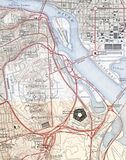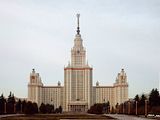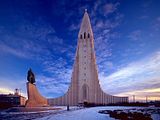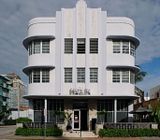the 1940s was an eventful decade as we all know.
World war 2 continued until Nazi Germany surrendered in 1945, Hitler committed suicide in the same year.
The atomic bomb was created, and used by the US against japan in the bombing of Hiroshima and Nagasaki, later the soviet union created there own atomic bomb.
The UN (united nations) and NATO were established, China became communist, the Deadsea scrolls were discovered, Polaroid camera invented as well as the state of isreal being formed. Quite an exciting decade. But what about art? creativity? design? what was going on through all the hustle and bustle, bullets and mid air battles of one of the biggest wars this world has ever seen? How did the war influence or change things, if it did?
CoBrA.Cobra, the name taken from the 3 cities it came from: Copenhagen, Brussels and Amsterdam.Brussels is the body, and Amsterdam is the tail, here illustrated by a drawing found in a book
written by Virtus Schade ' COBRA from head to tail' from 1971.

It was in the Paris café Notre Dame that Asger Jorn (from Copenhagen), Joseph Noiret and Christian Dotremont (from Brussels) and Constant, Corneille and Karel Appel (from Amsterdam) signed the manifesto 'La Cause était entendue’ (The Case was Heard). This manifesto, drawn up by Dotremont, was a response to a statement by the French Surrealists entitled 'La Cause est entendue' (The Case is Heard). In it Dotremont makes it clear they are no longer in agreement with the French artists. The CoBrA painters wanted to break new ground, preferring to work spontaneously and with the emphasis more on fantastic imagery. In 1951 the CoBrA movement was officially disbanded, yet during its short existence CoBrA rejuvenated Dutch modern art.
The influence of Danish art was the key to this movement and stayed there through out the period and was important because of internal conflicts and the lack of acceptance by the art establishment, especially in paris. Cobra was simply to different.
The CoBrA styleThe CoBrA artists painted directly and spontaneously. Just like children, they wanted to work expressively without a preconceived plan, using their fantasy and much colour.They rebelled against the rules of the art academies and aimed at a form of art without constraint. They also explored working with all kinds of materials: the experimental was paramount.
subject matterAnimals like birds, cats and dogs were favourite subjects, while fantasy animals and creatures were also much loved themes (some creatures were half-human, half-beast). Masks caught the CoBrA artists’ imagination and they further drew inspiration from mythology, children’s drawings, folklore, prehistory, eastern calligraphy, primitive art (non-western art from places like Africa and Oceania) and art by the mentally disabled.
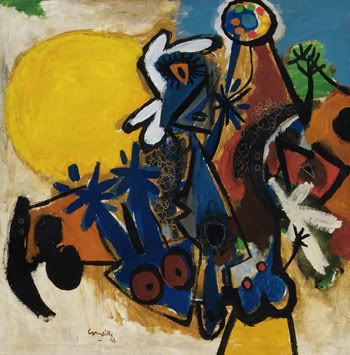
The theories of CoBrAA few CoBrA artists were not only involved with making art works but also with theorising about art and the role of the artist in society. Asger Jorn, Christian Dotremont and Constant Nieuwenhuys were very much preoccupied with this. They positioned themselves according to the communist theories of Karl Marx and supplemented his ideas with views on art. Their aim was to have art made for and by everyone, irrespective of class, race, intellect and educational level. Jorn, Dotremont and Constant aspired to an art form that spontaneously evolved out of the artist’s fantasy.
Jorn wrote about the relationship between art and architecture, seeing both inextricably linked. He used a photograph of a primitive hut decorated by its occupants to show how beautiful the combination could be. Jorn’s ideals were realised in several collaborative projects by the CoBrA artists.
useful links :
www.cobraart.dkwww.cobra-museum.nlhttp://fr.wikipedia.org/wiki/Cobra_(mouvement)___________________________________________________________________________________
The Manhatten ProjectThe Manhattan Project was the project to develop the first nuclear weapon (atomic bomb) during World War II by the United States, the United Kingdom, and Canada. Formally designated as the Manhattan Engineer District (MED), it refers specifically to the period of the project from 1941–1946 under the control of the U.S. Army Corps of Engineers, under the administration of General Leslie R. Groves. The scientific research was directed by American physicist J. Robert Oppenheimer.
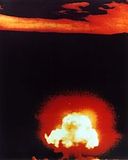
en.wikipedia.org/wiki/Manhattan_Project____________________________________________________________________________________
Art Informel French term describing a wide swathe of related types of abstract painting highly prevalent, even dominant, in the 1940s and 1950s, including tendencies such as Tachism, Matter Painting, and Lyrical Abstraction. Mainly refers to European art, but embraces American Abstract Expressionism. The term was used by the French critic Michel Tapié in his 1952 book Un Art Autre to describe types of art which had in common that they were based on highly improvisatory (ie informal) procedures and were often highly gestural. Tapié saw this art as 'other' because it appeared to him as a complete break with tradition. An important source of this kind of painting was the Surrealist doctrine of automatism. An exhibition titled Un Art Autre was organised in Paris the same year as Tapié's book and included Appel, Burri, De Kooning, Dubuffet, Fautrier, Mathieu, Riopelle, Wols. Other key figures were Henri Michaux, Hans Hartung and Pierre Soulages. The term Art Autre, from the title of Tapié's book, is also used for this art, but Art Informel seems to have emerged as the preferred name.
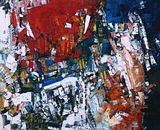
http://www.tate.org.uk/collections/glossary/definition.jsp?entryId=28___________________________________________________________________________________
LettrismLettrism is a French avant-garde movement, established in Paris in the mid-1940s by Romanian immigrant Isidore Isou. In a body of work totalling hundreds of volumes, Isou and the Lettrists have applied their theories to all areas of art and culture, most notably in poetry, film, painting and political theory. The movement has its theoretical roots in Dada and Surrealism. Isou viewed his fellow countryman, Tristan Tzara, as the greatest creator and rightful leader of the Dada movement, and dismissed most of the others as plagiarists and falsifiers.[1] Among the Surrealists, André Breton was a significant influence, but Isou was dissatisfied by what he saw as the stagnation and theoretical bankruptcy of the movement as it stood in the 1940s
1940s * 1942–1944. Isou develops the principles of Letterism, and begins writing the books that he would subsequently publish after his relocation to Paris.
* 1945. Aged twenty, Isou arrives in Paris on August 23 after six weeks of clandestine travel. In November, he founds the Letterist movement with Gabriel Pomerand.
* 1946. Isou and Pomerand disrupt a performance of Tzara’s La Fuite at the Vieux-Colombier. Publication of La Dictature Lettriste: cahiers d’un nouveau régime artistique (The Letterist Dictatorship: notebooks of a new artistic regime). Although announced as the first in a series, only one such notebook would appear. A subtitle proudly boasts of Letterism that it is 'the only contemporary movement of the artistic avant-garde'.
* 1947. Isou’s first two books are published by Gallimard: Introduction à une nouvelle poésie et à une nouvelle musique (Introduction to a New Poetry and a New Music) and L'Agrégation d’un nom et d’un messie (Aggregation of a Name and a Messiah). The former sets out Isou’s theory of the 'amplic' and 'chiselling' phases, and, within this framework, presents his views on both the past history and the future direction of poetry and music. The latter is more biographical, discussing the genesis of Isou’s ideas, as well as exploring Judaism. Isou and Pomerand are joined by François Dufrêne.
* 1949. Isou publishes Isou, ou la mécanique des femmes (Isou, or the mechanics of women), the first of several works of erotology, wherein he claims to have bedded 375 women in the preceding four years, and offers to explain how (p. 9). The book is banned and Isou is briefly imprisoned. Also published, the first of several works on political theory, Isou’s Traité d’économie nucléaire: Le soulèvement de la jeunesse (Treatise of Nuclear Economics: Youth Uprising).
link:
en.wikipedia.org/wiki/Lettrism#1940s_____________________________________________________________________________________
Neo-Romanticism Term applied to the imaginative and often quite abstract landscape based painting of Paul Nash, Graham Sutherland and others in the late 1930s and 1940s. Their work often included figures, was generally sombre, reflecting the Second World War and its approach and aftermath, but rich, poetic and capable of a visionary intensity. It was partly inspired by the visionary landscapes of Samuel Palmer and the Ancients, partly by a more general emotional response to the British landscape and its history. Other major Neo-Romantics were Michael Ayrton, John Craxton, Ivon Hitchens, John Minton, John Piper, Keith Vaughan. The term sometimes embraces Robert Colquhoun and Robert MacBryde, and the early work of Lucian Freud. Also the graphic work of Henry Moore of the period, especially his drawings of war time air raid shelters. In the early 1920s in Paris a group of figurative painters emerged whose brooding often nostalgic work quickly became labelled Neo-Romantic. Chief among them were the Russian born trio of Eugène Berman and his brother Leonid, and Pavel Tchelitchew.
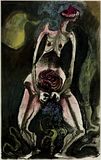
www.tate.org.uk/collections/glossary/definition.jsp?entryId=192_____________________________________________________________________________________
SurrealismMovement launched in Paris in 1924 by French poet André Breton with publication of his Manifesto of Surrealism. Breton was strongly influenced by the theories of Sigmund Freud, the founder of psychoanalysis. Freud identified a deep layer of the human mind where memories and our most basic instincts are stored. He called this the unconscious, since most of the time we are not aware of it. The aim of Surrealism was to reveal the unconscious and reconcile it with rational life. The Surrealists did this in literarature as well as art. Surrealism also aimed at social and political revolution and for a time was affiliated to the Communist party. There was no single style of Surrealist art but two broad types can be seen. These are the oneiric (dream-like) work of Dalí, early Ernst, and Magritte, and the automatism of later Ernst and Miró. Freud believed that dreams revealed the workings of the unconscious, and his famous book The Interpretation of Dreams was central to Surrealism. Automatism was the Surrealist term for Freud's technique of free association, which he also used to reveal the unconscious mind of his patients. Surrealism had a huge influence on art, literature and the cinema as well as on social attitudes and behaviour.
# 1942 - First Papers of Surrealism - New York - The Surrealists again called on Duchamp to design an exhibition. This time he wove a 3-dimensional web of string throughout the rooms of the space, in some cases making it almost impossible to see the works.[10] He made a secret arrangement with an associate's son to bring his friends to the opening of the show, so that when the finely dressed patrons arrived they found a dozen children in athletic clothes kicking and passing balls, and skipping rope. His design for the show's catalog included "found", rather than posed, photographs of the artists.[4]
# 1947 - International Surrealist Exhibition - Paris
http://www.tate.org.uk/collections/glossary/definition.jsp?entryId=292
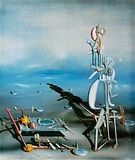
other links/info:
http://www.surrealism.org/http://www.surrealist.com/
en.wikipedia.org/wiki/Surrealismhttp://www.gosurreal.com/history.htmlhttp://www.artcyclopedia.com/history/surrealism.html_____________________________________________________________________________________
Abstract ImpressionismAbstract Impressionism is an art movement originating in New York City in the 1940’s. This was the first American movement to gain worldwide recognition, and put New York at the center of the art world; an achievement formerly awarded to Paris. Robert Coates coined the term ‘abstract impressionism’ in 1946 in one of his critiques of the new artwork. The most important predecessor of abstract impressionism is Surrealism, which also emphasizes spontaneous and subconscious creation. The name of this period reflects the combination of unique self expression with emotional intensity, and contrasts the ideas or Futurism and Cubism. Abstract Impressionism is a form of art where the artist expresses himself through the use of form and color, with no objective representations. The movement can be divided into two groups: the Action Painting expressed by artists like Pollock and De Kooning; and Color Field Painting practiced by Rothko and Noland. Famous artists of this movement include Pollock, Gorky, Riopelle, Rothko, de Kooning, Motherwell, and Kline; their works possess very different moods and subjects, yet share qualities such as sizable canvasses, flat compositions, and the fact that all areas of the piece are filled with movement and paint (instead of creating a focal point, or an area of the most interest).
In the 1940s there were not only few galleries (The Art of This Century) but also few critics who were willing to follow the work of the New York Vanguard. There were also a few artists with a literary background, among them Robert Motherwell and Barnett Newman who functioned as critics as well.
http://www.arthistoryguide.com/Abstract_Impressionism.aspx

links:
artists-
http://dir.yahoo.com/Arts/Art_History/Periods_and_Movements/Abstract_Expressionism/Artists/http://en.wikipedia.org/wiki/Abstract_expressionism_____________________________________________________________________________________
World War 2 PropagandaWorld War II saw continued use of propaganda as a weapon of war, both by Hitler's propagandist Joseph Goebbels and the British Political Warfare Executive.
Some historical revionists claim that the use of gas chambers in the Holocaust is an instance of an effective Allied propaganda campaign that could not be reined in after the war, much like the now discredited claim made during the Gulf War that Iraqi soldiers were ripping newborn babies out of incubators and throwing them to the ground.
http://www.world-war-2.info/propaganda/http://www.teacheroz.com/WWIIpropaganda.htmgoogle images.
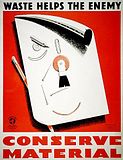
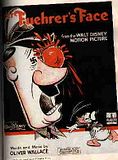
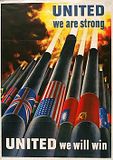
___________________________________________________________________________________
Socialist RealismSocialist realism is a teleologically-oriented style of realistic art which has as its purpose the furtherance of the goals of socialism and communism. Although related, it should not be confused with social realism, a type of art that realistically depicts subjects of social concern.
The term, Socialist Realism, probably first occured in print in an article in the Literary Gazette in May 1932. It stated: "The masses demand of an artist honesty, truthfulness, and a revolutionary, socialist realism in the representation of the proletarian revolution." In 1933, Maksim Gorki published an important article, "On Socialist Realsim", talking of "a new direction essential to us - socialist realism, which can be created only from the data of socialist experience."
The Socialist Realism, an ideology enforced by the Soviet state as the official standard for art, literature etc., was defined in 1934 at the First All-Union Congress of Soviet writers. It was based on the principle that the arts should glorify political and social ideals of communism. Every artist had to join the "Union of Soviet Artists", which was controlled by the state. The paintings had to be idealisations of political leaders and communist ideas.
http://members.surfeu.at/horvath/realism.htmen.wikipedia.org/wiki/Socialist_realismhttp://www.socialistrealism.com/
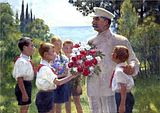
_____________________________________________________________________________________
Modernism 1940sModernism's second generation (1930–1945)
Modernism after World War II
The Post war period left the capitals of Europe in upheaval with an urgency to economically and physically rebuild and to politically regroup. In Paris (the former center of European culture and the former capital of the art world) the climate for art was a disaster. Important collectors, dealers, and modernist artists, writers, and poets had fled Europe for New York and America. The Surrealists, and modern artists from every cultural center of Europe had fled the onslaught of the Nazis for safe haven in the United States. Many of those that didn't flee perished. A few artists notably Pablo Picasso, Henri Matisse, and Pierre Bonnard remained in France and survived.
The 1940s in New York City heralded the triumph of American Abstract expressionism, a modernist movement that combined lessons learned from Henri Matisse, Pablo Picasso, Surrealism, Joan Miró, Cubism, Fauvism, and early Modernism via great teachers in America like Hans Hofmann and John D. Graham. American artists benefited from the presence of Piet Mondrian, Fernand Leger, Max Ernst and the Andre Breton group, Pierre Matisse's gallery, and Peggy Guggenheim's gallery The Art of This Century, as well as other factors.
During the late 1940s Pollock's radical approach to painting revolutionized the potential for all Contemporary art that followed him. To some extent Pollock realized that the journey toward making a work of art was as important as the work of art itself. Like Pablo Picasso's innovative reinventions of painting and sculpture near the turn of the century via Cubism and constructed sculpture, Pollock redefined the way art gets made at the mid-century point. Pollock's move - away from easel painting and conventionality - was a liberating signal to his contemporaneous artists and to all that came after. Artists realized that Jackson Pollock's process - working on the floor, unstretched raw canvas, from all four sides, using artist materials, industrial materials, imagery, non-imagery, throwing linear skeins of paint, dripping, drawing, staining, brushing, essentially blasted artmaking beyond any prior boundary. Abstract expressionism in general expanded and developed the definitions and possibilities that artists had available for the creation of new works of art.
The other Abstract expressionists followed Pollock's breakthrough with new breakthroughs of their own. In a sense the innovations of Jackson Pollock, Willem de Kooning, Franz Kline, Mark Rothko, Philip Guston, Hans Hofmann, Clyfford Still, Barnett Newman, Ad Reinhardt and others opened the floodgates to the diversity and scope of all the art that followed them.
en.wikipedia.org/wiki/Modernismtate:
http://www.tate.org.uk/collections/glossary/definition.jsp?entryId=174artists:
Pablo Picasso
also see:
fauvism
cubism
_____________________________________________________________________________________
Possible influences pre 1940.The Bauhaus
After looking in depth at the Bauhaus and the work produced there during my time at college and knowing it was having such a massive effect on the world of art and design at the time I cant help but wonder what would of happened if the Nazi party hadn't closed it down in 1933.
Or if it had closed later on in the 30's, would it of had a bigger effect and been a larger influence to the 40's. Would some of these movements in the 40's even happened?
To me the Bauhaus being forced to shut in 33 was a real shame and I firmly believe had it of stayed open the 1940s and onwards would of been very different.
_____________________________________________________________________________________

